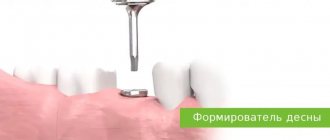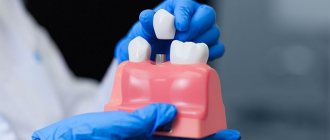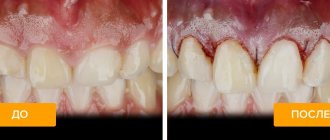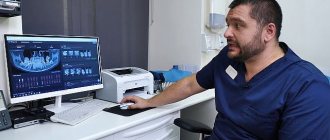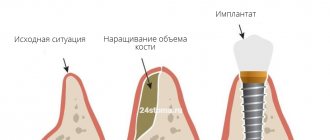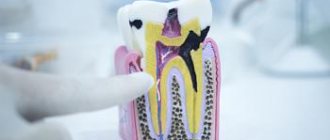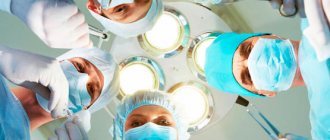- Indications
- Contraindications
- Methods
- Stages of treatment
- Prevention of complications
- Advantages of the ROOTT Clinic
- Prices
- Doctors
- Reviews
If a tooth is lost, dentists recommend implantation as soon as possible. There are several reasons, the main one being bone loss. However, there are reasons that are not so obvious, but still important. For example, gum recession. Lack of blood supply and stress in the area of the missing tooth lead to the fact that the soft tissues decrease in volume and the gums shrink. The roots of the teeth are exposed, and in the absence of teeth, the contour of the gums changes. The smile becomes less attractive, and problems arise during implant placement. In such cases, they resort to gum plastic surgery during implantation.
- When to use:
gum recession, gingival contour restoration - Procedure time:
up to 1 hour - Treatment period:
from 1 day - After the procedure:
compliance with medical recommendations - Type of anesthesia:
local
Indications
The gums may recede when:
- no load;
- periodontal diseases;
- tissue detachment;
- defects caused by injuries.
By tightly adhering to the artificial tooth, soft tissues solve several problems:
- Form an aesthetic gum margin
- Protects the bone tissue around the implant from infection
- Prevents plaque from accumulating in gum pockets
Gum augmentation during implantation can be carried out during the installation of the implant or after its engraftment. It depends on what problem the soft tissue transplantation solves.
Classification of gum formers
Modern technologies make it possible to produce several classes of structures - from budget to premium. All of them do an excellent job with their assigned function – restoring the correct shape of the gums. Differences occur in the quality of the material and the method of manufacture and processing. The majority of designs have universal sizes that are suitable for any patient. The most expensive ones are made individually for each specific patient. But, as a rule, this is not necessary at all - it is easier to perform plastic surgery on the mucous membrane.
In general, formers, like any other superstructures (components for an implant kit), should be installed from the same brand that you chose for dental implantation.
The main classes of shapers (just based on manufacturers):
- budget: Implantium, Alpha Bio - made in Korea and Israel,
- mid-price category: German, for example, XiVE,
- premium: Straumann, Nobel Biocare, Astra Tech - made in Switzerland, USA or Sweden.
Contraindications
Contraindications for plastic surgery are the same as for implantation. They are divided into relative and absolute. New methods of surgical intervention and materials make it possible to reduce the list of conditions for which gingivoplasty is not recommended. Even if the patient has systemic diseases, only a doctor is able to assess all the risks and make a decision on whether to perform surgery.
Relative
the procedure can be carried out with extreme caution
- Inflammation in the oral cavity;
- exacerbation of chronic diseases;
- caries on neighboring teeth;
- dental plaque and tartar.
Absolute
the procedure is strictly prohibited
- Diseases that interfere with blood clotting;
- chemotherapy;
- uncompensated diabetes.
Preparing for surgery
Gingivoplasty requires preliminary preparation of the patient. Before the procedure, the doctor must conduct laboratory tests and studies. For example:
- determination of prothrombin in the blood;
- blood sugar levels;
- HIV test;
- cardiac echocardiography;
- coagulogram.
Depending on the results obtained, additional specialist consultations may be required.
It is better to take an accompanying person with you for the operation itself, as it is performed under anesthesia. Those who have had gum grafting know that applying an ice pack to the injured area is very useful.
Before visiting the hospital, it is not advisable to overeat; it is enough to have a light snack. It is prohibited to drink alcohol a week before the procedure. Clothing must be without a collar.
Methods
Most often during implantation:
- eliminate gum recession;
- build up the alveolar ridge;
- restore gingival papillae.
The alveolar ridge is the process of the jaw that forms the tooth socket. In the absence of a tooth, the bone tissue decreases, the process becomes flat. There may not be enough space to strengthen the implant.
Alveolar ridge plastic surgery is performed with bone material of artificial or natural origin. A block of bone tissue is placed on the alveolar process, covering the gum tissue on top. This is done before installing the implant.
After the implant has healed, a gum former is installed on it. However, this is not always enough for the appearance of gingival papillae - the tissue that fills the space between the teeth. Then plastic papillae are performed after installation of implants. The procedure is performed using the same flap technique as other operations. The autograft is transplanted onto the gum so that it fills the space between the teeth.
The same technique is used for gum recession.
Average cost in Moscow
Here are the approximate prices in metropolitan clinics for implantation and other dental services related to it.
| Name of service | Cost, rub. |
| Turnkey implantation | |
| Classical implantation with installation of a metal-ceramic crown | 39100 |
| Classical implantation with installation of an all-ceramic crown | 50200 |
| Removable prosthesis on implants with ball-shaped fastening | 54700 |
| Express implantation with installation of a metal-ceramic crown | 58000 |
| Classical implantation with installation of a ceramic crown on a special alloy | 60000 |
| Removable denture on implants with beam fastening | 160000 |
| Installation and removal of implants | |
| Installation of the healing abutment | 3700 |
| Implant removal | 6900 |
| Implantation of osteoconductive material in the area of 1 tooth | 9600 |
| Installation of a mini implant | 11700 |
| Implantation of a protective membrane of 1 tooth | 12700 |
| Installation of a temporary implant | 14700 |
| Express implantation (in one stage) of 1 tooth | 33900 |
| Classic implantation of 1 tooth | 44800 |
Cost of medications to relieve inflammation and pain at home
| Medication | Cost, rub. |
| Chlorhexidine 0.05% | 60 |
| Betadine 10% | 270 |
| Solcoseryl | 300 |
| Amoxiclav | 330 |
| Dexalgin | 400 |
Stages
1. Preparatory
The examination shows whether additional manipulations are needed, such as curettage or cleaning teeth from plaque.
2. Pain relief
The operation is performed under local anesthesia
3. Formation of flap, tissue extension
The epithelial tissue is capable of regeneration, and the patient's palate will not be damaged after the tissue is taken for transplantation.
4. Stitches and disinfection
The stitches are removed after 10-14 days.
Some clinics use a laser device instead of a scalpel. This reduces trauma and shortens the healing period, but increases the price of gum surgery after dental implantation.
When is soft tissue plastic surgery performed?
The procedure is indicated if you need to achieve the proper aesthetic appearance, as well as in case of existing defects of the following nature:
- multi-level arrangement of the gingival margin;
- congenital pathologies of the dental system;
- a cosmetic defect that appeared due to previous treatment or mechanical trauma to a fragment of the jaw;
- excessive tension of gum tissue and disruption of their development during prosthetics;
- pressure of incorrectly installed dentures on the mucous membrane;
- neglect of hygiene rules in the postoperative period;
- covering a significant part of the tooth space with gum (shark smile);
- tissue failure, exposure of root areas;
- formation of periodontal pockets;
- inflammation of soft structures during teething;
- problems with the labial or lingual frenulum;
- formation of the gingival contour during prosthetics after implantation, as well as if the operation is performed several years after tooth extraction.
Prevention of complications
- do not eat for 5-10 hours after surgery;
- do not drink for at least 2 hours;
- wear a mouthguard if your doctor recommends it;
- use an irrigator in the first 2 days instead of brushing;
- rinse your mouth after eating;
- exclude hot, spicy, salty foods;
- postpone or reduce physical activity in the first week.
If the swelling does not subside within several days, there is pain, the temperature rises, and bleeding appears, you should immediately seek help. If the recommendations are followed, problems rarely arise.
To avoid complications, it is better to perform soft tissue plastic surgery before and after implantation in a highly reputable clinic.
Article Expert
Argunova (Sivova) Tatyana Anatolyevna Dentist-therapist, doctor of the highest category
Work experience: more than 5 years
What options are possible after implantation?
In dental surgery, various gum correction techniques are used.
Installing a gum former - step by step
This is a stage located on the border of surgery and orthopedics. Placement of the former is one of the components of classical dental implantation. Its essence is the creation of an anatomically correct gum shape. The former is a metal structure in the form of a cylinder, rising 2-3 mm above the gingival level. Its step-by-step installation looks like this:
- Anesthesia.
- Dissection of the mucosa above the implant.
- Cleaning the head of the pin from overgrown bone.
- Unscrewing the cover screw.
- Installation of the shaper.
- Suturing (as indicated).
Use of membranes
Sometimes gingivoplasty is performed using absorbable and non-absorbable membranes. The operation is carried out as follows:
- Introduction of anesthetic.
- Cutting soft tissue down to the bone and moving it to a new position.
- Installation of the membrane.
- Stitching.
Complete healing usually takes at least a month. Then the prosthesis is placed. If membranes were used during the implantation process, then this method is no longer suitable for gingivoplasty .
Application of grafts
The procedure has three variations:
- transfer of tissue from a nearby area;
- transplantation from the same zone;
- removal and movement of tissue from the palate.
In the first two cases, the operation consists of several stages:
- Anesthesia of the area around the implant and the site of graft collection.
- Incision and detachment of the mucoperiosteal flap.
- Move the fabric to the prepared area.
- Stitching.
After a week, the sutures are removed and the success of integration is checked. The fact that everything is normal is indicated by the pink tint of the fabric.
The prosthesis is placed in three to four weeks, after everything has completely healed.
Moving the flap from the palatal part is performed in almost the same way, only the wound surface will be much larger. As a result, the patient may experience pain after surgery.
Using artificial gum crowns
Plastic surgery is used for large and minimal defects. Another common way to solve the problem is to install crowns with artificial gums. The purpose of such structures is to partially recreate the missing tissues. However, aesthetically they are not perfect . The artificially created area is a ceramic veneer and will most likely look different from the natural gum. This option is acceptable for patients with a not very high smile line.
Reasons to contact ICDI ROOTT
- The clinic uses unique methods of implantation, bone and gingivoplasty.
- The center is a member of the European organization of dentists Open Dental Community, which means it has access to new developments and methods
- The clinic's doctors have extensive experience working with bone and soft tissue plastic surgery.
- The clinic performs operations on patients who were refused elsewhere due to contraindications.
- ROOT is a multidisciplinary clinic - all services are provided in one place.
- The clinic uses an attractive financial policy, which makes the cost of services ultimately lower than the Moscow average.
- The clinic pays special attention to the safety of treatment through multi-level sterilization.
How to care for your gums during the adaptation period
The rehabilitation period after implantation and prosthetics usually takes at least five months. At this time, it is important to follow all doctor's recommendations. Typically the list of appointments includes:
- regular visits to the dentist;
- brushing your teeth with a soft-bristled brush;
- daily rinsing of the mouth with antiseptic solutions;
- avoidance of the implantation area during hygiene procedures;
- gently cleansing gums that have been injured with a cotton swab;
- use of floss, irrigator;
- refusal to visit the sauna, bathhouse, or take a hot bath;
- limiting the consumption of solid foods;
- exclusion from the diet of spicy, sour, hot, cold foods;
- strict control over the healing process.
An important point for gum health is quitting smoking. Tobacco smoke negatively affects the condition of the mucous membrane and is the main provocateur of implant rejection. Therefore, it is better to get rid of a bad habit.
Installation during pregnancy
Serious hormonal changes occur in the body of the expectant mother. Metabolism is being restructured, because Fetal nutrition is carried out at the expense of the resources of the mother's body. Against this background, the expectant mother’s immunity decreases, bones and teeth become more fragile. Therefore, dentists do not recommend dental implantation during pregnancy and lactation - so as not to burden the body and not harm the baby with medications.
However, a gum abutment is a more routine procedure. If you are faced with the fact that you had an implant installed before pregnancy and the need to fix the former fell just during this period, it is still worth postponing this stage until after the birth of the baby. After all, both the surgical intervention itself and the local anesthesia that is given during any treatment pose a rather great danger. In addition to the anesthetic, the injection may contain epinephrine (adrenaline), which is contraindicated for pregnant women. In exceptional cases, the installation of a former is allowed only in the second trimester of pregnancy and only with the permission of an obstetrician-gynecologist and dentist. But it is better to postpone this procedure until lactation is completed and the body is completely restored.
Author: Vasiliev A. A. (Thank you for your help in writing the article and the information provided)
